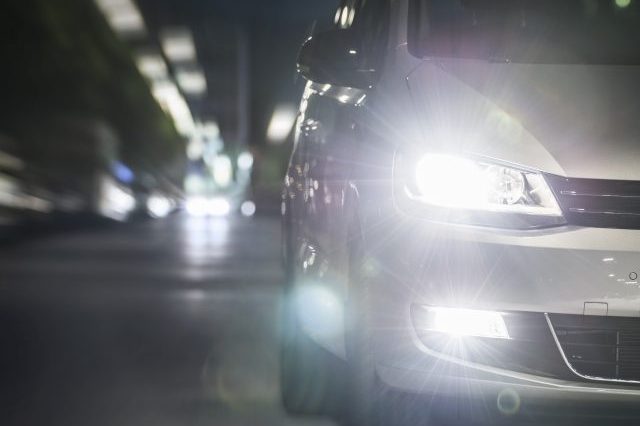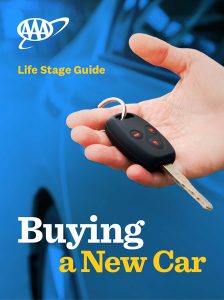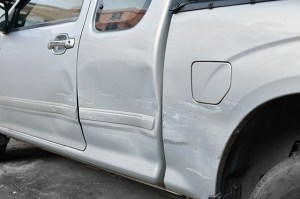Drivers are increasingly complaining about the intense LED headlight glare that comes from newer vehicles, but the issue is not as clear as one might think.
The U.S. is taking baby steps toward smart headlight systems that adjust their beams based on what is in their path and look less harsh to oncoming drivers, but they still could be years away from hitting the roads.
Why Are Headlights So Bright These Days?
Some experts say several factors are contributing to drivers reporting glare. One is that LED lights are not brighter, but the blueish-white light emitted is more irritating to the human eye. The others relate to the position of the headlights, the height of newer vehicles and older drivers.
AAA has published numerous studies about headlights and related issues such as glare and did not find a problem, according to Greg Brannon, director of automotive engineering and industry relations for AAA Inc. “LEDs put more light on roads where people need it,” he said. “There is no evidence that LED lights are a hazard.”
Drivers Disagree
Still, drivers are reporting discomfort and being blinded by oncoming cars with LED headlights and some are calling for them to be banned.
“There is a problem,” acknowledged Dr. John Bullough, director of the Light and Health Research Center at the Icahn School of Medicine at Mount Sinai in New York City. “There are some issues (with headlights) people are experiencing more than they did 10-to-20 years ago, and they are making more people complain. But the basic regulations for headlights and how they produce light in certain directions have been the same for several decades. Technology has changed.”
Over the past 10 years, automakers transitioned to LEDs and high-intensity discharge (HID) headlights from halogen headlights, which produce soft yellow light, which is easier on the eyes. On the plus side, LED bulbs last longer and an LED array has many small bulbs, which can be shifted in different directions to shape the beam. The white light also makes it easier to spot road markings and more closely resembles daylight.
But there are drawbacks. “They tend to make glare more noticeable and uncomfortable,” according to Bullough.

Calls to Regulate LED Headlights
Groups such as the Soft Lights Foundation argue that the use of LED and HID headlights “has become a source of dangerous, blinding glare,” and has an online petition asking Congress and federal agencies to regulate LEDs. More than 50,000 people have signed the petition so far.
Other factors are contributing to people experiencing headlight glare, according to Bullough. Many vehicles are higher now, so lights on SUVs and trucks shine directly into the eyes of sedan drivers, he said. “Passenger cars get a brighter splash of light.”
Also, headlights are often misaligned, and drivers don’t realize it. “Consistently, over a few decades, a lot of cars have poorly misdirected headlights,” said Bullough. “If they are too high, the beam hits (oncoming drivers) in the eyes. If they are too low, drivers can’t see much past their car.” Not all states require headlight alignment to be assessed, he added.
The aging of the U.S. population also plays a role, Brannon maintained. There were almost 48 million licensed drivers ages 65 and older in 2020, according to the latest research from the Centers for Disease Control and Prevention. That is a 68% increase over 20 years ago. “New technology looks different coming toward older drivers, when they are used to seeing a soft yellow glow,” he said. “The LED and HID lights draw drivers’ attention, and then they have a problem with a glare.”
People’s ability to see in the dark decreases every year after age 40, Brannon added, and drivers are less able to recover from glare. To cope with glare, Brannon recommended drivers modify their gaze and look at the road, not the oncoming headlights.
Smarter Headlights Are on the Way
If anything, headlights on U.S. cars should be brighter, Brannon said. The U.S. has a much lower maximum output for high beams than most countries and standards have not changed in decades. AAA research shows that 64% of American drivers do not extensively use their high beams, often out of concern for other drivers. But driving with low beams all the time can be a safety hazard. “If you are driving with low beams over 35 mph and encounter something in the road, you can’t stop in time,” according to Bullough.
Changes are coming, although slowly. More new cars in the U.S. have automatic high/low beam switching systems, which allow drivers to use their high beams all the time, because the headlights switch to low beams if they detect an oncoming vehicle.
Even more advanced technology is available, but not in the U.S., and although high-tech headlights have been approved here, it still could be years before drivers actually see them. Since 2013, Europe and most of the world have been using adaptive driving beam (ADB) headlights, which produce more light and automatically change the direction of the beam to reduce glare for oncoming drivers or pedestrians while not losing forward illumination.
Despite urging from multiple organizations, including AAA, the type of ADBs used by most of the world have not been approved for use in the U.S.
Crafting New ADBs
In 2022, the National Highway Traffic Safety Administration (NHTSA) approved ADB headlighting systems similar to what is used in other countries, but with different criteria for performance, according to Bullough.
The U.S. Department of Transportation drew up glare-proof specifications for ADB headlights, but more testing and information are required. Vehicle manufacturers are waiting for detailed specifications before starting to build and install these systems, to avoid misinterpretations and recalls, according to Bullough.
Because these headlights will be brighter, the changes also will require some adjustments by drivers, but the headlights are overdue, said Brannon. “Modern headlight systems put light where you need it,” he said. “Over time, people will become more accustomed to it.”
Need headlight maintenance? Visit your nearest AAA Approved Auto Repair Facility. Members can save up to $75 per visit – that pays for your membership! Search for AAR facilities.
How do you feel about headlight glare? Share your thoughts in the comments below.
218 Thoughts on “What’s the Story With Headlight Glare?”
Leave A Comment
Comments are subject to moderation and may or may not be published at the editor’s discretion. Only comments that are relevant to the article and add value to the Your AAA community will be considered. Comments may be edited for clarity and length.












Today’s Headlights are absolutely blinding! I drive a sedan and can not safely drive at night now. I had to get a prescription pair of special yellow tinted eye glasses to make it somewhat reasonable to handle the glare. This must be changed. USA so far behind in safety in so many ways!
My husband and I find the LED headlights to be blinding even when the headlights are on low beam. The lights are especially blinding when higher on trucks, SUV’s, etc. both in oncoming traffic and when behind our vehicle.
It’s also a real problem when reflected in rear view mirror and side mirrors.
No mention of ppl just buying replacement LEDs off Amazon and installing themselves in cars. And if you search these aftermarket LED bulbs they range in lumen intensity which is the main cause of light glare. Most of these LEDs have lumen intensity for off-road use. Do an article on this which is the problem. not the car manufacturer
Headlight glare is definitely more and more of a problem for our aging population. The fact that our laws have not already required headlight glare control like some other countries is shameful. Too much time seems to be wasted by our lawmakers on issues of personal or party gain and fund raising.
I am grateful that i’ll never have to replace my driver side headlamp again. There was barely enough room between the battery and the lap top remove it and replace it, and 3 screws holding the hood release cable in place also needed to be removed. LEDs will probably never need to be replaced. However it seems that while incandescent bulbs out put light across the visible spectrum fairly evenly, LED’s have a much narrower spectrum and concentrate their output there. It looks to me like green, orange and white reflectors work very well in the LED light, but red and the occasional blue reflector seem duller in LED light then they did in incandescent light. It also does seem like a lot of peoples lights are not adjusted properly, when a trailing car lights up the inside of my car it’s nearly always LED lights doing this. As for automatic beam switching, i recently drove a rental, and the damned car wouldn’t allow me to turn the high beams on when there were no cars around. it seemed to mistake reflectors for tail lights. i’ll never get automatic high beams. I do think that day time running lights are a great safety feature and if you have them use them. if you don’t, please turn you lights on in tunnels, especially if you’re driving a dark colored car with no chrome. Please also use your full lights in rain storms, not your parking lights, those just don’t do the job.
AAA : “duplicate comment”. “Looks like you have already made that comment” ???? WHAT?
I’ve SLOWly become accustomed to oncoming LED’s in past few years. Just got new car, and what I CAN’T adjust to is drastic cut-off on the top of my headlights beams. I live in hilly terrain with lots of curves in road, too. Driving into a dip in road, suddenly lose sight of much of oncoming roadway. Lots of fun in middle of curve. And if I am cresting a rise, I can imagine and see reaction of oncoming car as it suddenly catches LED under cutoff. Lots of fun…….not
I often experience glare from oncoming headlights and find it hard to determine why : are their high beams on? Is it because it is a truck and is higher directing their beams at eye level for lower riding cars? Or is it because their beams are in fact very much brighter LEDs? My sense is auto manufacturers do pretty much what they think are such great ideas and if you buy what is apparently a good car, these “great” ideas come with it. Like the remote FOB that automatically unlocks the door as you approach the door. What – does the car company think : you are being chased by a gang of killers and that you need the door unlocked to escape? What is so demanding about taking the key out of your pocket and hitting the unlock button? I like to drive to an area to exercise and would usually hide my key somewhere under my car. But I cannot do that anymore as the car will be unlocked! Now that is inconvenient …
I agree with your critique of the remote starter/key!! They also are vulnerable to hackers!! However, nowadays you very well could be running from a gang of killers!! Also however, jumping into your car wouldn’t save you from such a gang!! The second amendment might!!!
I don’t know how this story gets done and doesn’t mention IIHS’s work and the progress that has been made. “Manufacturers have taken steps to reduce glare as part of their response to IIHS headlight ratings. For the 2023 model year, only 6% of the headlight systems tested had excessive glare, compared with 20% in the 2017 model year.” Here is the link https://www.iihs.org/topics/headlights
What a condescending expert. I am in my 30s and for years have dealt with being blinded by LEDs. I do watch the lines in the road and don’t look into on coming traffic. I can no longer use my rear view mirror because I am blinded by LED lights reflecting in my rear view and side mirrors. As a result of LED lights I can no longer safely drive at night which is a serious problem.
Along with Blinding glare from LED headlights is the directional signals lamps/lights in use are blinded out by the LED headlights.
Orangeish Amber directional signals were more prominent years ago.
I’m 75 years old and have trouble with night driving due to the glare from oncoming traffic. To compensate I’ve purchased
yellow glasses that fit right over my prescription glasses. This has solved my problem!
Blinding! Even driving in the city. I’ve considered wearing sunglasses at night…cue song.
As far as age?? This has been discussed with a broad range of people of different ages
And if it isn’t the oncoming lights -it’s the lights in the rear view mirror & side mirrors. You just can’t get away from them!!
What a condescending expert. I am in my 30s and for years have dealt with being blinded by LEDs. I do watch the lines in the road and don’t look into on coming traffic and I can no longer use my rear view mirror. As a result of LED lights I can no longer safely drive at night which is a serious problem.
1) Totally agree that newer headlights can be blinding, especially to drivers of compact sedans/wagons. Suggest all headlights be subject to a maximum height over road limitation, regardless of front design (Have seen over the road trucks with suitably low mountings; new Ford Bronco is dazzling both coming at you and in the rear view mirror)
2) Sealed beam headlights always threw a limited amount of light well down the road, allowing drivers to pick up road signs, lane markings, etc. well down the road even at highway speeds, without blinding oncoming drivers. More ‘modern’ designs create a blackout limit beyond which nothing is visible, and 35 mph is about the limit of safe operation, whereas running lights provide longer reach at the expense of less near-term detail — far better for use on rural roads/parkways with limited oncoming traffic but roadside issues.
3) The adaptive headlight issue is yet another instance of the auto industry using phony ‘safety’ issues to create trade barriers isolating the US market from Europe, ending the ability of US motorists to pick from a broader array of more suitable products (as a good example, absence of manual shift models that are readily available in Europe). AAA should be lobbying for a policy that US and EU/UK standards (safety, crash test, lighting, etc.) are functionally equivalent, acceptable for US use without further Federal or state regulation, acceptable for private imports, and unacceptable as a legal claim in a lawsuit.
Thanks for a very timely article on a critical safety topic !
The statement of Greg Brannon, director of automotive engineering and industry relations for AAA Inc. “LEDs put more light on roads where people need it,” he said. “There is no evidence that LED lights are a hazard.” <—-excerpted directly from the subject AAA article, is misleading when he states "…no evidence that LEDlights are a hazard."
As thankfully also reported in this article, 50,000 drivers can't be wrong…and that ddoesn't include the many thousands more (including me) who would have signed that petition had the opportunity been there.
"Near-miss" accidents aren't recorded, but for every collision there might be as many as 10 or more "near-misses", but for good luck/fortune in circumstances.
It is undeniable that the LEDs have not been 'designed' or 'structured'/positioned in the automoble/motor vehicle headlights to eliminate or vastly reduce that known gare factor/hazard.
If any decisionmakers in this area are reading this, then expressing here as a DDC (Defensive Driving Course) Instructor of five years:
Thanks for considering !
P J G, Sr.; M.A., JD
Missing road lines create need for brighter lights. 80% of all local roads controlled be state highway commissions are DEVOID of any center lines on all northeastern states. State highways including interstates are 50% DEVOID OF PAINTED LINES.
I have called local and state authorities no less than 40 times on the past year and while they recognize my name and remember my request to paint road lines they say it’s out of their control or the weather and it never gets fixed. This is a safety hazard and brighter lights avoid accidents due to roads not having lines. This problem is outrageous in MA.
Have the matter investigated and that is where you will find answers about lights.
Good luck.
Kenneth Goldberg
Lynnfield MA
Yep!! The “no evidence” trope is used whenever someone wants to deflect unwanted criticism of their preferred mantra!! There’s “no evidence” that you’re about to be eaten until you turn around and see tiger!!!
That petition is still up and is active with a march 2024 updated correspondence. So far, nearly 100 new signatures today
Thank you so much for your response. There is definitely a problem with the headlights, they are so bright and glaring that I literally have stopped driving at night. When I need to go out at night, I am constantly looking for a ride. That is ridiculous when there are 50,000 drivers complaining about the same thing.
Patsy
The worst though is the drivers who leave on their brights on purpose. Also happens to be every single jeep wrangler owner. Just sayin’
These studies miss the most important facts. The new cars with LED’s are fine. They are aimed very accurately and don’t cause many problems at all.
The older cars have terrible headlight output so all these kids put LED bulbs in so they can see and the LED bulbs in older headlight buckets have a terrible light spread – they weren’t designed for these new LED bulbs – and they irritate other drivers. And let’s not forget about the brodozers with the LED light bars. That’s what the people have an issue with.
This is absolutely true. Headlights designed for LEDs have a distinct cut-off line that prevents the lights from affecting oncoming drivers. Halogen housings are not designed for the output pattern from LEDs.
Good points!! And… it’s not just the “kids”!!
You’re 100% correct… The other issue is that Amazon sells ridiculously bright LED’s and some of them even have to be wired into the car to power the fans that keep these lights cool. There’s no regulation, so anyone can buy them and turn their vehicle into an nuisance for other drivers. And the worst part is, if you flash your beams at these people to make them aware their high beams are on, they actually hit you back with their actual beams and it all but blinds you. You’d think they’d know their lights are super bright and understand your error thinking their beams are on and just let it go, but no… Most of them blind you back unnecessarily.
The reason people are complaining about the lights is because they are too bright. A person driving in rush hour traffic has no problem with seeing. But they are giving everyone else a problem. The cars are higher and the lights are blinding people. It’s not that the older people aren’t “used to” the lights. Don’t blame the victim
It’s the lights. I plan to drive in rush hour traffic with my high beams on all the time to join in the fun of blinding and annoying other drivers while waiting for the young jerks who created this to fix the problem they created.
Have to agree with your comment, SG., there seems to be no choice at this point.
The manufacturers are very likely going to face some hefty lawsuits as an incentive to adjust the technology back down to the capabilities of the human optical anatomy !
AAA has published numerous studies about headlights and related issues such as glare and did not find a problem, according to Greg Brannon, director of automotive engineering and industry relations for AAA Inc. “LEDs put more light on roads where people need it,” he said. “There is no evidence that LED lights are a hazard.”
Thousands upon thousands of people, including myself, are being blinded each night by bright headlights and this Brannon fella is saying there’s no evidence that the LED lights are a hazard.
Not sure what type of evidence he’s searching for, but I’m familiar with anecdotal evidence.
I’m 59 and my vision is just fine, thank you… 20/20 in fact. I’m with SG – the only alternative for folks with lower vehicles is to keep our high beams on regularly. The industry and “technology” have created this mess.
I agree that a change to European style adaptive headlights is overdue
LOL!! I just went from a Mercury Mountaineer to a Toyota Echo and noticed right away that now the on-coming headlights are right on my eye level!!!
Spot on!!! Thanks for saying this…